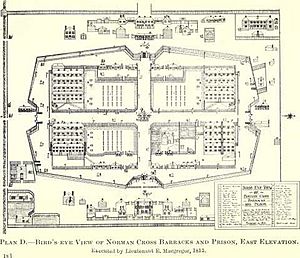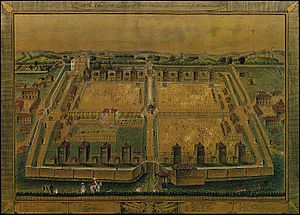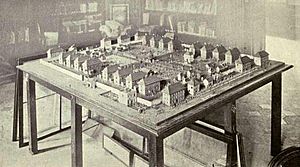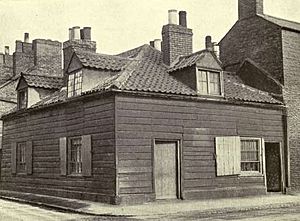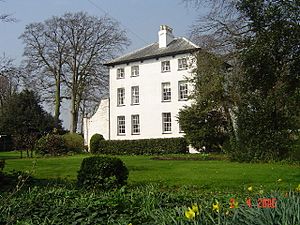Norman Cross Prison facts for kids
Norman Cross Prison was the world's first prison built especially for holding prisoners of war. It was built in Huntingdonshire, England, between 1796 and 1797. This prison held soldiers and sailors captured during the French Revolutionary Wars and Napoleonic Wars. Most of the prisoners were from France and its allies. After the war ended, the prison was mostly taken down in 1816.
Norman Cross is located south of Peterborough, in what is now Cambridgeshire. It's near the villages of Folksworth, Stilton, and Yaxley. This area was important because it was on the main road connecting London to the north.
Contents
Building the Prison Camp
The British Royal Navy's Transport Board was in charge of looking after prisoners of war. In 1796, they needed a new prison because many prisoners were coming from the Caribbean. They chose the Norman Cross site because it was on the Great North Road, about 76 miles (122 km) north of London. It was also far enough from the coast, so it would be hard for prisoners to escape and get back to France. The area also had good water and enough food nearby for thousands of prisoners and guards.
Building started in December 1796. Many parts of the wooden buildings were made in London first, then put together on site. About 500 carpenters and workers built the prison in just three months.
The prison was designed like an old army fort. It had a wide ditch inside the main wall to stop prisoners from digging tunnels. Guards watched from hidden spots. The soldiers guarding the prison lived outside the main prison area. A large guard house, called the Block House, was in the very center. It held troops and six cannons.
Inside, the prison had four main sections, called quadrangles. Each section had four large wooden buildings, each holding 500 prisoners. There were also washing areas. One building was kept for officers. Half of each quadrangle was a big exercise yard. The prison hospital was in one of the sections. There was also a special punishment block, called the Black Hole, where prisoners were kept for bad behavior. Many wells were dug to provide drinking water for everyone.
Life Inside the Prison
On average, about 5,500 men were held at Norman Cross. The highest number recorded was 6,272 prisoners in April 1810. The prison was meant to be a good example of how to treat prisoners of war kindly.
Most of the prisoners were regular soldiers and sailors. Some senior officers and important civilians, like passengers from captured ships, were allowed to live outside the prison on "parole." This meant they promised not to escape and were treated with respect. Some even hired servants and went out to dinner! A few officers even married English women while on parole.
Clothing and Food
The British government provided clothes for the prisoners, but some prisoners gambled away their clothes. So, the government started giving them bright yellow suits, caps, jackets, and red waistcoats. These bright colors made it easier to spot anyone who tried to escape.
Prisoners' food was prepared by other prisoners who were paid a small amount. Each prisoner got a daily ration of beef, bread, potatoes, and cabbage or peas. On Fridays, fish was given instead of beef, as most prisoners were Catholic. They also received soap. Later, the French government sent food supplies for their citizens. The British government made sure the food was good quality, and senior prisoners could inspect it.
Learning and Fun
Many prisoners could not read or write. The prison offered them a chance to learn in their own language and in English. Books were available for those who could read. Prisoners were also told about the war news.
Prisoners were very creative. They made things like toys, model ships, and domino sets from carved wood or animal bones. They also made straw pictures. These items were sold to visitors and people passing by the prison gate. The prices were controlled so they didn't hurt local businesses. Prisoners could use the money they earned to buy extra food, tobacco, or materials for more crafts. Some prisoners became quite rich from their work!
Thousands of these handmade items can still be seen today in museums, like the Peterborough Museum and Art Gallery.
Health and Care
Sick prisoners were treated in the prison hospital. At first, French surgeons looked after them. As more prisoners arrived, diseases spread. A serious typhus outbreak happened in 1800-1801, and many prisoners died. A special cemetery was dug near the camp for them.
Doctors also saw cases of pneumonia and tuberculosis. In 1806, many prisoners got a strange condition called night-blindness, where they couldn't see in the dark. They were cured with a special plant called black hellebore. In total, at least 1,770 prisoners died at Norman Cross, mostly from illness.
Escapes and Challenges
Prisoners often tried to escape. Sometimes, large groups would try to break through the fences. Soldiers had to stop them, and some prisoners were hurt. After big escape attempts, the wooden fence was replaced with a strong brick wall, 14 feet (4.3 m) high and nearly a mile (1.6 km) long.
Some prisoners dug tunnels, while others hid in carts leaving the prison. One time, three French prisoners escaped and stole a boat to try and get back to France. Sadly, one prisoner was shot and died while trying to climb over the prison fence.
The End of the Prison
Many prisoners arrived at Norman Cross after long marches from ports like Portsmouth and Plymouth. When the war ended in 1814, Napoleon was defeated, and peace was declared. Prisoners, guards, and local people celebrated together.
The first group of 500 prisoners left on April 5. Some prisoners drank too much on their way to the coast, and a few died. Many prisoners took thousands of pounds of English money home with them, earned from selling their crafts.
By June 1814, all the remaining prisoners had left. A few decided to stay in England and settled near Yaxley and Stilton.
What Remains Today
The wooden prison buildings were taken down in June 1816, and the parts were sold. Some buildings were moved to nearby towns, but much of the wood was sold as firewood.
The site of Norman Cross Prison is now a protected historical site. The house where the prison commander lived, called the Old Governor's House, is still standing. The old stables are now an art gallery. Norman House, where the barrack master lived, also survives.
A Special Memorial
A monument was built in 1914 to remember the 1,770 prisoners who died at Norman Cross. It stood beside the Great North Road. The bronze eagle on top was stolen in 1990 but was replaced in 2005 after people raised money.
When the A1 highway was improved in 1998, the memorial had to be moved. On April 2, 2005, the Duke of Wellington helped unveil the restored memorial at its new spot beside the A15 road. A new bronze eagle, made by an artist named John Doubleday, was placed on top.
Studying the Past
An archaeological dig took place at the site in 2009, as part of the TV show Time Team. They uncovered parts of the prison wall, a building where prisoners lived, a washing hut, and a burial ground.
Images for kids


